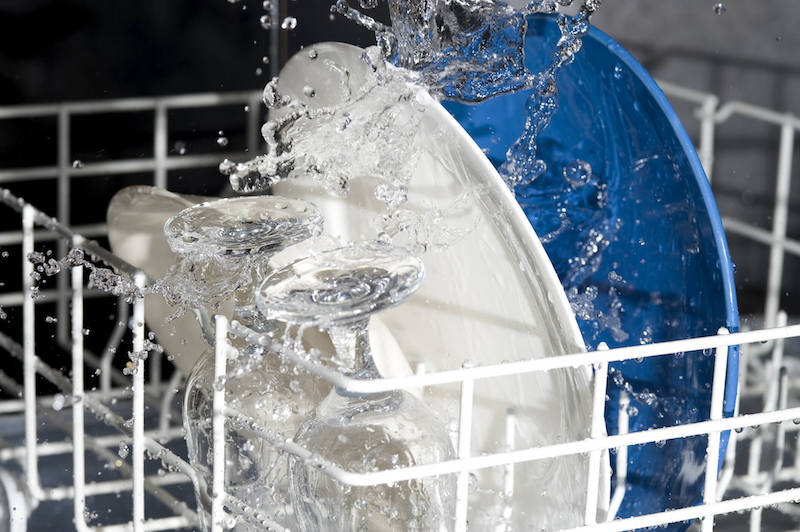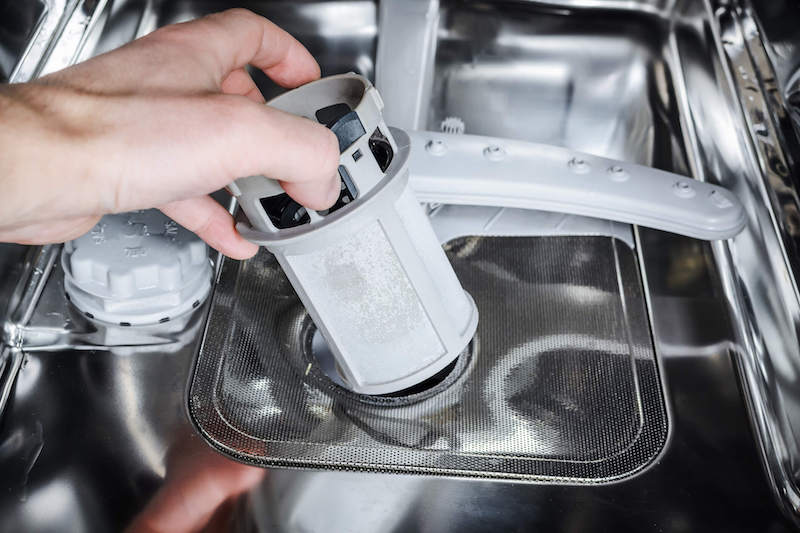Cooking and baking are the lifeblood of a kitchen. Whether we’re tackling a foody passion project, bringing the family together for mealtime, or snagging a midnight munchy, crafting a yummy dish is what the kitchen is all about! That’s why dishwashers are the crème de la crème of kitchen gadgets. These amazing pieces of technology can be a homeowner or renter’s best friend, but they can also be a kitchen nightmare that would make Gordon Ramsay cringe. Just imagine how gross a moldy dishwasher is... Yuck!

We don’t always consider how icky these cleaning machines can be, though. We’re too focused on loving them for their magical ability to wash dishes so that we don’t have to. That love is especially strong for those of us whose chore every day was washing dishes in the sink by hand. Every single dish, every single day, and they had to be spotless or else we’d have to start all over again. Some of us probably still have flashbacks of watching our parents bake or cook a big meal and sweating thinking about how long we’d be washing dishes afterward.
Kind of like those stories our grandparents told us about walking to school uphill both ways in the snow! Now, we can just quickly rinse off any dirty dishes, throw them in the dishwasher, hit that start button, and relax in the living room while it works its cleaning magic.
Those freshly cleaned dishes may not be as clean as we thought, though, if they’re covered in mold particles. Quite the opposite, in fact, because they could be making us and our families sick. This is why it’s important to prevent a moldy dishwasher and make sure it's clean and safe to use. The nauseating idea of what could be living inside of these cleaning machines is kind of motivation enough, but it’s also for our continued health!
But First, a Mold Crash Course!
Before getting into preventing a moldy dishwasher, it’s best to understand what this fungus is and why it’s important to avoid it. So let’s set the stage.
There are over 100,000 species of mold identified so far, and they all reproduce by creating microscopic spores.¹’² Kind of like the seeds that a weed releases.
These invisible spores then float out into the air and ride the current wherever that may lead. Again, like seeds. We all probably encounter a few of these spores throughout the day, either in our car, at home, or walking into work and we’d never even know it because they’re invisible.
Meeting a few spores a day typically cause no problem at all.
The issue arises when a mold spore finds a nice, comfy living space inside of our homes. Mold growth in nature? Vastly important to help ensure the continuation of natural processes like decomposing dead matter. Mold growth inside of a home, though? Creates horrible air quality that can begin to affect the health of those in that indoor space.

Instead of only encountering a few spores throughout the day, the home is now packed full of these particles that are just floating all around that indoor air and sticking to anything they come in contact with. Think of it like a moldy snow globe. Some species of mold can also create microscopic toxins called mycotoxins when they feel threatened and they happen to be naturally toxic to the body.³ It’s an environmental exposure nightmare.
Mold Exposure’s Drama With Health
All of these foreign particles can wreak havoc on our health.⁴’⁵ The immune system tags them as invaders and will do its best to remove them, but prolonged exposure can cause the immune system to get worn out and malfunction. Researchers are still hard at work attempting to determine exactly how mold exposure can affect us, but there are quite a few factors to consider. Genetics, length of exposure, species of mold involved, presence of mycotoxins, and state of the immune system all play a role. What they do know is that anyone with a compromised or developing immune system is at a greater risk of developing symptoms faster and to a greater extent.⁶’⁷
Some of the symptoms of mold exposure can include:
- Brain fog
- Chronic fatigue
- Rashes
- Coughing
- Watery eyes
- Sneezing
- Neurological issues
- Digestive problems
- Respiratory issues
Everyone responds to mold differently, though. Some people may experience zero symptoms, while others may experience 30. You just never know. That’s why it’s important to prevent things like a moldy dishwasher and all of the potential symptoms that can come with it.
Why Does A Moldy Dishwasher Occur?
A mold spore requires very little to transition into the world of the living. Four key components will give a spore the opportunity it needs to start growing and colonizing. ⁸
These ingredients for life include:
- Oxygen (they require very little)
- Temperature (most species prefer temperatures ranging from 40 to 90 degrees Fahrenheit, but some can survive in the extremes)
- Food (they’re trash pandas and eat almost anything)
- Moisture (some species need a lot, and others need very little)

When you think about it, dishwashers tick each of the boxes above. Water is involved in every single cycle, food particles abound, there’s plenty of oxygen, and while the high temperature isn’t great, some species of mold just don’t mind. Dishwashers are also dark boxes, which is icing on the cake for a spore looking for life. That’s why mold oh-so-loves these cleaning machines!
Putting all the pieces together, it makes sense why a study found that 62 percent of the dishwashers they assessed had some type of fungal presence…⁹
The presence of this determined fungus in a dishwasher means that every dish, coffee mug, and utensil that we throw in for a wash is now covered in mold particles. Sometimes, mycotoxins come along for the ride too! And because these particles are invisible, you’d never know they were there. Exposure will keep continuing until the mold problem is solved. Not to mention, the spores that will be released into the indoor air, which is bad for the air quality and our health. Plus, the likelihood of a spore finding another place to opportunistically grow in and creating another problem just went way up.
In short, a moldy dishwasher can quickly lead to a moldy fiasco and moldy homes and cutlery are most definitely not what we want in our lives. That’s why preventing moldy dishwashers should be a key part of our kitchen cleaning checklist.
Preventing A Moldy Dishwasher
Stopping a mold problem before it starts involves routine cleaning and a few additional steps to eliminate food sources and extra moisture. Mold spores can grow in as little as 24 hours, so it’s important to stay on top of dishwasher maintenance.
Forewarning, one step involves checking and cleaning the filter that traps food. If you didn’t know your dishwasher comes equipped with a filter and/or have never cleaned it before… You might want to mentally prepare yourself because it might be filled with an unidentifiable sludge.
To ensure the dishwasher is sparkly clean, get ready to channel your inner Cinderella and follow the deep cleaning steps below at least once a month.

These steps include:
- Remove the racks, the rotor (the part that spins), and any other removable piece of the machine.
Check the manufacturer's manual for a complete breakdown list and their suggestions on cleaning methods. Every machine is different, so knowing how to properly clean your specific machine will help avoid any malfunctions.
- Scrub each piece with white vinegar (or Benefact), rinse, and wipe with a microfiber towel. Then wash them again with warm water and soap. Leave them out to air dry when finished.
Vinegar is a mold prevention rockstar. It’s a descaler, meaning that it strips away layers of particles from a surface, and it’s antibacterial and antifungal, which helps prevent mold and bacterial growth. Killing any existing mold that managed to sneak in isn’t the complete answer because some particles remain on the surfaces and will continue to cycle through the machine when it’s in use. Aka, the exposure will continue. You need something to discourage mold growth, strip particles away from the surface, and actively eliminate mineral buildup. Mold spores will eat food particles and mineral buildup, so both have got to go.
- Move onto the dishwasher filter next. Check the manufacturer’s instructions first so that you know how to properly remove it and how to clean it.
Again, every dishwasher is different, but the process should look similar to the other removable parts mentioned earlier.
- Throw some white vinegar (or Benefact) in a spray bottle, grab a small brush (like a toothbrush), and scrub all of the little corners, parts, and crevices inside of the dishwasher. This includes the area that houses the filter and the drain opening!
The hard-to-reach areas are the places mold spores love the most, so pay careful attention to these spaces/pieces.
- Grab a larger scrubby brush and take care of the sides, top, and bottom as well.
- Tackle the door next, especially the rubber seal and gasket. This includes the inside and outside of the door.
Vinegar is completely fine to use on stainless steel, so fear not!
- Wipe every part down with those trusty microfiber towels.
Microfiber towels are 100 times better at wiping away small particles like mold fragments and spores.
- Replace all of the disassembled parts.
- Place 1-2 cups of vinegar in a dishwasher-safe bowl, place this on the top rack, and run a dishwashing cycle on the hottest setting.
- When this cycle is finished, leave the door open so that it can dry completely.
This cleaning process will help keep your dishwasher free from mold growth and operating at its peak performance. That’s great news for you because you’ll be left with super clean dishes and a dishwasher with a longer lifespan. Plus, no mold exposure. It’s a win-win-win!
Also, do not use bleach! It can harm your dishwasher and while it will kill the mold, it will not get rid of the particles and exposure will continue. Even the EPA stands behind this. ¹⁰
There are a few other steps you can take as well to help make sure your favorite kitchen appliance is safe to use and fungus-free.
These include:
- Checking for any random food particles left behind after every use and wipe them away when found.
- Leaving the door cracked when not in use so the inside stays dry. Ventilation is key to decreasing the moisture that mold spores love. If the kiddos make this impossible, leave the door wide open for an hour after every use to dry it out and then close it!
- Running the garbage disposal (if you have one) before starting the dishwasher. They share a pipe that can become clogged with an overabundance of food particles.

Did You Discover a Moldy Dishwasher?
If you find mold, don’t panic. Mold growth happens even if you work your tail off to prevent it. It’s just a seriously tenacious fungus!
Complete the deep cleaning steps above, but scrub, rinse, and wipe every part at least three times to ensure all contaminants are eliminated. Mycotoxins are particularly difficult to remove from surfaces, so you want to go above and beyond to make sure this machine is safe to use and that those harmful particles are actually gone. When in doubt, contact an expert to ask questions.
After the mold removal, keep an eye out to see if the mold growth comes back quickly (and keep using your nose too in case the mold is hidden!). If it does return immediately after the mold removal, consider hiring a professional to come in and assess if there’s a larger problem causing the mold growth.
Not In Our House!
If kitchens are the heart of the home, then dishwashers are their backbone! Moldy dishwashers put a bit of a kink in that supporting role, though. By maintaining solid mold awareness, knowing where mold spores love to grow, and preventing them from creating a cozy little dwelling, we can keep our cooking spaces clean and safe.
That way, we can focus on what matters, like spending time with our families and friends, crafting yummy concoctions, and creating memories that will last forever. None of which involves moldy dishes! Health starts at home.

Citations:
- Environmental Protection Agency. (n.d.). Mold. EPA. Retrieved from https://www.epa.gov/mold.
- Centers for Disease Control and Prevention. (2020, August 11). Basic facts about mold and dampness. Centers for Disease Control and Prevention. Retrieved from https://www.cdc.gov/mold/faqs.htm.
- World Health Organization. (n.d.). Mycotoxins. World Health Organization. Retrieved November 18, 2021, from https://www.who.int/news-room/fact-sheets/detail/mycotoxins.
- Environmental and Occupational Health Assessment Program, & Environmental and Occupational Health Assessment Program, & Health Science Section, Mold Basics for Primary Care Clinicians (2009). Hartford, CT; Connecticut Department of Public Health. , H. S. S., Mold Basics for Primary Care Clinicians 1–10 (2009). Hartford, CT; Connecticut Department of Public Health.
- Curtis, L., Lieberman, A., Stark, M., Rea, W., & Vetter, M. (2004). Adverse health effects of indoor molds. Journal of Nutritional & Environmental Medicine, 14(3), 261-274.
- Bush, R. K., Portnoy, J. M., Saxon, A., Terr, A. I., & Wood, R. A. (2006). The medical effects of mold exposure. Journal of Allergy and Clinical Immunology, 117(2), 326-333
- Fisk, W. J., Lei-Gomez, Q., & Mendell, M. J. (2007). Meta-analyses of the associations of respiratory health effects with dampness and mold in homes. Indoor air, 17(4), 284-296.
- Lstiburek, J., Brennan, T., & Yost, N. (2002, January 15). Rr-0208: What you need to know about mold. Building Science Corporation. Retrieved November 18, from https://www.buildingscience.com/documents/reports/rr-0208-what-you-need-to-know-about-mold/view.
- Zalar, P., Novak, M., de Hoog, G. S., & Gunde-Cimerman, N. (2011). Dishwashers–a man-made ecological niche accommodating human opportunistic fungal pathogens. Fungal biology, 115(10), 997-1007.
- Environmental Protection Agency. (n.d.). Should I use bleach to clean up mold? EPA. Retrieved December 7, 2021, from https://www.epa.gov/mold/should-i-use-bleach-clean-mold.
- EPA. (n.d.). A Brief Guide to Mold, Moisture, and Your Home. EPA. Retrieved from https://www.epa.gov/mold/brief-guide-mold-moisture-and-your-home#tab-6.

